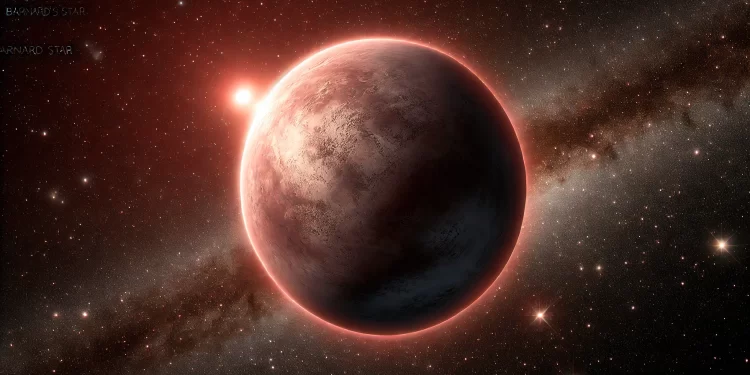Astronomers have made a groundbreaking discovery: a planet orbiting Barnard’s star, the closest single star to our solar system. This exciting find was made using the European Southern Observatory’s Very Large Telescope (ESO’s VLT) in Chile, offering fresh insights into our cosmic neighborhood. Barnard’s star, which is just six light-years away from Earth, has long been a target in the search for Earth-like planets due to its proximity and potential for hosting habitable worlds.
A Newly Discovered Exoplanet and More to Come?
The newly identified exoplanet, known as Barnard b, is a rocky planet with at least half the mass of Venus and an incredibly short orbital period—just over three Earth days. It sits twenty times closer to its star than Mercury does to the sun, leading to extreme temperatures of around 125°C on its surface. Unfortunately, this proximity means it lies well outside the “habitable zone,” the region where liquid water could exist, making it an inhospitable environment despite the cooler nature of its host star.
While Barnard b is the focus of this discovery, astronomers have also detected signals that hint at three additional exoplanet candidates orbiting Barnard’s star. Further observations are needed to confirm their existence, but this could mean that our closest stellar neighbor is home to multiple planets, adding excitement to the search for habitable worlds beyond Earth.
Barnard’s Star: A Stellar Target for Planetary Discovery
Barnard’s star, the second-closest stellar system after Alpha Centauri, has intrigued astronomers for decades. With a distance of just six light-years, it’s within the perfect range for detailed study with modern telescopes. Red dwarfs like Barnard’s star are especially appealing because their smaller, cooler nature makes it easier to detect low-mass planets—like Barnard b—compared to larger stars like our sun.
This discovery is the result of five years of patient observation using ESO’s VLT, as well as data from other exoplanet-hunting tools such as HARPS and CARMENES. While it took time to uncover Barnard b, astronomers are optimistic that this could be just the beginning, with more discoveries on the horizon.
This discovery was made possible through the use of a highly precise instrument known as ESPRESSO. This tool measures tiny “wobbles” in a star’s movement caused by the gravitational pull of orbiting planets. The data gathered by ESPRESSO was cross-checked with information from other leading instruments, further confirming the existence of Barnard b. However, the signals suggesting additional planets require more observation to be verified.
What’s Next in Exoplanet Exploration?
The discovery of Barnard b is just the start of what could be a much larger planetary system around the star. As new instruments come online, like the upcoming Extremely Large Telescope (ELT) equipped with the powerful ANDES instrument, researchers are preparing to take exoplanet studies to the next level. These advanced tools will allow astronomers to detect even smaller, rocky planets in temperate zones and study their atmospheres in unprecedented detail.
“This discovery reinforces the idea that our cosmic backyard is full of low-mass planets,” says lead researcher Jonay González Hernández. He is confident that with future observations, even more exoplanets in the Barnard’s star system could soon be revealed.
As scientists continue to uncover the mysteries of stars close to our own, each discovery adds another piece to the puzzle of whether life could exist elsewhere in the universe. The confirmation of Barnard b, and the potential discovery of more planets in its system, fuels optimism about finding more Earth-like worlds within our cosmic neighborhood. The future of exoplanet exploration looks bright, and Barnard’s star remains a key player in the hunt for planets that could, one day, reveal life beyond Earth.











